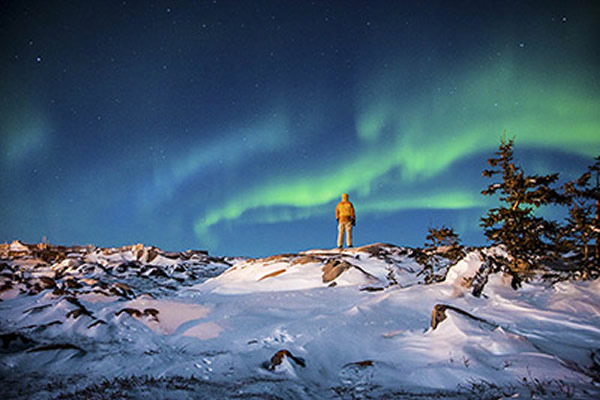
Man watching the Northern Lights
When we landed in Churchill, Manitoba, Canada, on Mar 11, the mercury huddled at minus 20 F. It was blowing a full gale, making the wind chill beyond ridiculous ... something like minus 40, which is the same whether you’re speaking Fahrenheit or Celsius.
Our aim was to "do" winter in Churchill, a small town on the southwest rim of Hudson Bay and better known as Polar Bear Central. Each fall, 10,000 people stomp through this town of 850 during the bear season, another several thousand come for beluga whales in summer and now, there's a thriving winter season whose main feature is predictable, absolutely breathtaking northern lights. Meanwhile the bears, mostly, are asleep or elsewhere so you can safely walk about the land.
So why come up here in winter? To see weather like you've probably never seen before, to see northern lights, to experience winter play ... dogsledding, snowshoeing, snowmobiling.
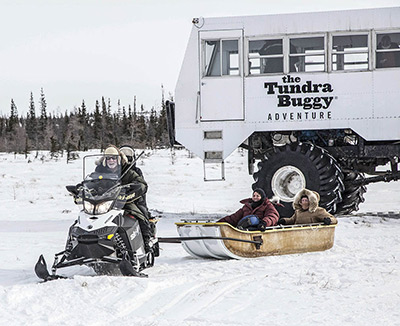
Good way to get around on the tundra
The first thing my friends all discovered was that NO one had proper clothes. Luckily, the Polar Inn just happens to rent deep winter duds. The parka, itself, is large, thick and heavy enough to stand up unsupported, though most just went with the thick pants and super insulated boots.
Getting dressed in this climate is quite an experience: first heavy thermal underwear, then thick wool socks, warm vest or sweater, along with down filled snow pants, boots, neck gaiter, balaclava AND hat, down filled parka with fur ruffed hood, fleece glove liners and, whew, down filled mittens.
And what we did once we were geared up, was go someplace. In this case, out for a dogsled run and a tromp through the woods on snowshoes.
So, first, the puppies. Dave Daley, owner of Wapusk Adventures, has a couple dozen dogs who live to race. In fact, he was getting ready to head off for the Hudson Bay Quest, a qualifier for the world famous Iditarod.
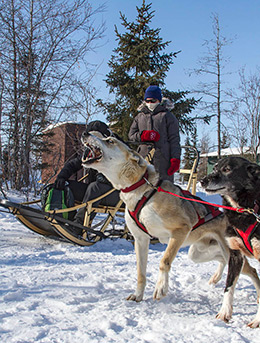 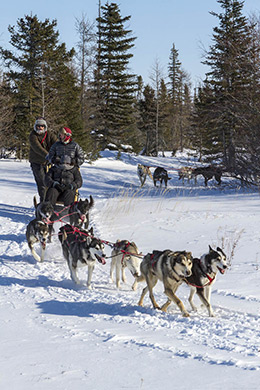 
“You do this out of passion for the dogs, certainly not to get rich,” he said about racing. Last year, he spent $8,000 to race the Quest and won $500. The winner got $2,000. Not exactly a great bottom line.
As for the dogs, themselves, Dave explained, “you train these dogs with love and respect, not fear and intimidation.”
To do this, Dave is “the big dog,” the alpha head of the pack. He hugs the dogs, he kisses them and occasionally, he flips them gently on their backs and looks them in their eyes so they know who is boss.
“These dogs live to run,” he added.
And indeed, they do. Each team strained at their harnesses before we started our short demo run. They barked, they whined, they bounced with anticipation. And when it was time, the command was not “mush,” but “hike.”
The word “mush,” by the way, comes from the French marche, which means, more or less, “to go.”
So, we took off ... Through the woods, past trees and around curves. It was fun. It was exciting. And yes, it was cold.
That night, it was northern lights. We went out in Frontier North Adventure’s tricked out Tundra Buggy. We’re talking house on wheels, with comfy couches, tables, two propane heaters, food, booze and, yes (whew) bathroom. We headed out across the tundra, stopping along the frozen Churchill River where a line of evergreens gave us something to put in our foreground.
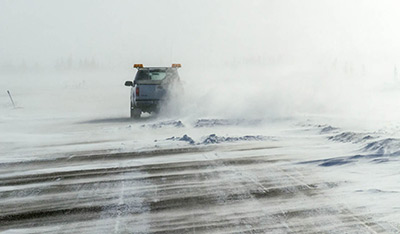 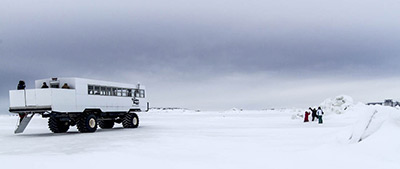
Driving in a blizzard You can see why it's called a tundra buggy
Though the aurora forecast said “low,” the lights had something else in mind. Starting with a faint green glow, they grew to become red tinged ribbons flowing, bending, writhing across the entire sky.
Northern lights (aurora borealis), we learned, happen when sun spots send electrically charged particles that interact with the earth's magnetic field and various gasses in the atmosphere. The energy from this is released as colored light ... green/red for oxygen, purple/blue for nitrogen.
But for us, the best came (as it always seems to) at 1 a.m. when the green glow morphed into two arcs, like green rainbows, which then sent spiked fingers that turned into a porous fan that covered the ENTIRE sky. It was a pulsing, folding curtain with white hot knots that melted and twisted like something alive.
We yelled. We screamed. A few of us cried.
 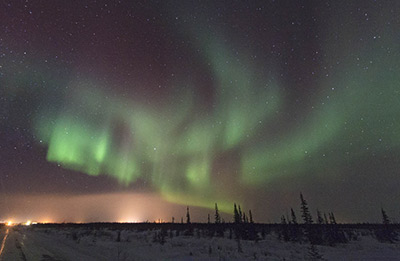
Northern Lights on display near Churchill, Manitoba
When we finally climbed back into the buggy, our guide, Doug Ross, announced, perhaps a bit too gleefully, that his thermometer had registered 35 below.
So of course, with temps like that, the next day our intrepid group went out on snowshoes with long time Churchill resident Mike Macri.
First we visited his cabin, which, he explained, “is not your peeled log and granite fireplace kind of lodge,” No, it’s a simple, one room building crammed with outdoor gear, a few cabinets, table, chair, bed and walls lined with plywood.
The woods looked asleep but they weren’t. Mike stopped by an open spot with faint marks in the snow. Those marks had been made by a ptarmigan using its wings and beak to brush snow aside and dig a hole for the night, where he lined it with his pellet-like, well, poo, and slept warm till the morning.
There was also time to explore town ... Including, but of course, Gypsy’s Bakery with its plate size apple fritters (hey, when it’s minus 40 outside, no food is off limits).
The Eskimo Museum has shelves lined with the most amazing Inuit sculptures.
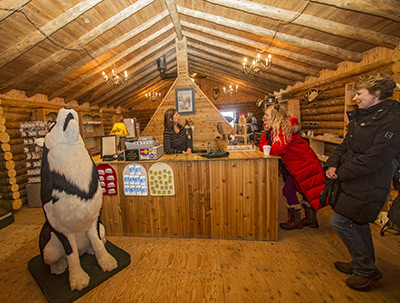 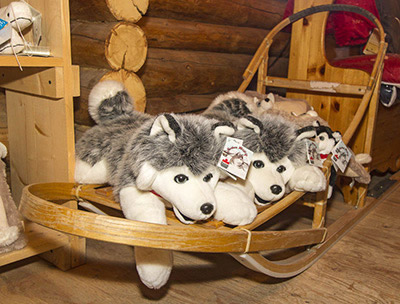
Toys in the Churchill souvenir shop

Carving in the Eskimo Museum
It wasn’t until Europeans started buying carvings that the Inuit started making their statues big (meaning large enough to see without a magnifying glass). When you are a nomad, carting around a 20 pound chunk of stone or ivory doesn’t make sense. So the earlier carvings were truly small and one in the case was made from a hunter’s own extracted tooth which he shaped into two almost microscopic figures of Inuit men.
The Via Rail station has been made into a museum with dioramas depicting a mother polar bear in her den with cubs and a typical Cree Indian skin tent, among others. Plus, don’t miss the movies, especially the one about northern lights and the building of the railroad.
And, well, of course everyone went into the post office to get their passports stamped.
Our last night, a few of us walked to the edge of town where a huge Inukshuk, an Inuit travel marker made of stones, sits on the edge of Hudson Bay.
By now, it was 2 am, or so, and probably somewhere around minus 50 with the wind chill. We scrambled across a couple of snow drifts, set up behind one for a windbreak and stood in awe as green and red curtains of light played across the sky.
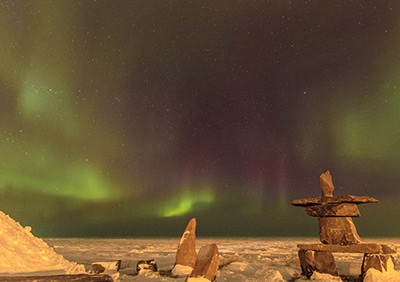 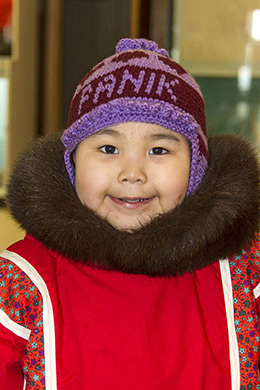
Northern Lights above an inukshuk Inuit girl
It was truly amazing and, honestly, I didn’t even feel the cold.

Playing at an igloo
AURORA MYTHS ... AND FACTS
* Inuits and Alaskan Eskimos feared the lights, some talking softly to them to fend of the evil spirits, others waving sharp knives at them.
* Southern Europeans thought they were a sign that war was coming.
* The Norse thought they were reflections off shields of spirits who led dead soldiers to the afterlife.
* Icelandic people thought a pregnant woman who looked at the lights would give birth to a cross-eyed baby.
* On the other hand, Scandinavians thought they foretold good fishing or a rich harvest.
* And Japanese to this day believe conceiving under them will bring the baby good luck, so many travel to Alaska just for this purpose.
* Lights have been seen as far south as Florida and Greece.
* Lights actually exist in an oval about 1,000 miles from the magnetic poles of both the Arctic (where they are called aurora borealis) and the Antarctic (where they are called aurora australis)
* There are northern (and southern) lights over other planets and have been seen on Saturn.
* After a sunspot blast, it takes two to four days for the solar particles to reach earth, which is why aurora forecasters can predict how strong the lights will be.
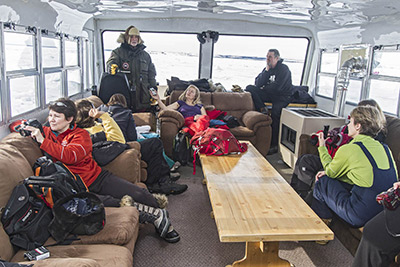
Inside the tundra buggy
INFO
* Though northern lights are there year round, you need dark skies to see them. Best time of year in most places is late February and early March.
* Ski clothes will NOT do the job for winter in a place like Churchill. Clothing rental (parka, pants, boots) runs about $45 a day through the Polar Inn: www.polarinn.com.
* For Churchill: http://everythingchurchill.com/
* Winter tours are offered in Churchill through Frontiers North Adventures, www.frontiersnorth.com, Churchill Wild, www.churchillwild.com and Churchill Northern Studies Centre, www.churchillscience.ca
* If you are traveling through Winnipeg, sign up for a northern lights clinic where you get to practice in the comfy (and warm) Manitoba Museum: http://www.manitobamuseum.ca
* For a neat glimpse by Amanda Williams of our days in Churchill: http://www.youtube.com/watch?v=ioCg5uuNmUQ
* Meanwhile, should you wish to figure out the explorer in yourself, Canada’s tourism site has provided a quiz to determine your “Explorer Quotient”: http://caen.canada.travel/ConsumerWeb/EQQuiz.page
* And for two truly amazing time lapse videos of the lights by Dan Harper (www.danharperphotography.com):
Http://www.youtube.com/watch?v=ZE-ur1B8b38
Http://www.youtube.com/watch?v=6_o_uk5rPAk |